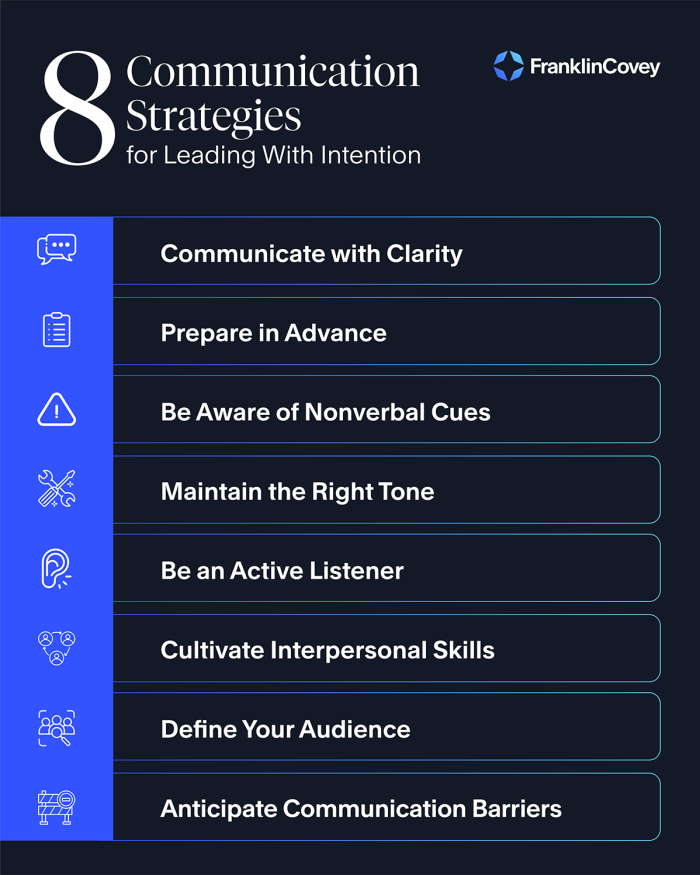8 Communication Strategies for Leading With Intention

Effective communication strategies are pivotal for leaders aiming to inspire purpose and propel lasting change. By practicing clarity, preparation, active listening, and purposeful nonverbal influence, leaders can improve their individual effectiveness and elevate organizational performance.
Effective communication is the foundation of intentional leadership. When leaders speak and act with purpose by choosing their words, tone, and delivery with care, they foster environments where clarity drives execution, values align across teams, and trust becomes a force multiplier. Communication that is clear, while remaining aligned with intent, cultivates accountability and fuels the cohesion necessary for high-performing teams.
When so much feels uncertain, clear communication can help align teams with a shared vision, engage team members with an unmistakable sense of purpose, and ensure goals are achieved. Below, we’ll outline eight communication strategies to help individual contributors and leaders alike sharpen their communication skills. Whether you’re seeking to strengthen clarity, enhance listening, or better understand your audience, these communication strategies will help you lead with purpose and achieve lasting impact.

1. Communicate With Clarity

Clarity is a secret superpower.
Why Clear Communication Is Essential
Clear communication is the foundation of trust and execution in any team or organization. When leaders express themselves unambiguously, they eliminate guesswork and cultivate a shared understanding of priorities. In contrast, vague or overly complex communication fosters confusion, misalignment, and eventually disengagement, thereby undermining momentum and morale. Effective leaders know that clarity is not accidental. It requires discipline and intention in every message they communicate.
How to deliver a clear message:
- Prioritize the essential. Before speaking or writing, determine what your audience absolutely must understand or act upon. Lead with that. When you learn how to put first things first, the aspects that matter the most won’t ever be at the mercy of the ones that matter less.
- Simplify your language. Use straightforward words that resonate across roles, departments, and levels of technical expertise. Replace abstract concepts with tangible examples.
- Avoid complexity that dilutes precision. Long explanations, layered caveats, or too much data can obscure the core of your idea. A simple message, repeated consistently, carries further and sticks longer than a nuanced one buried in jargon.
Leveraging the Power of Brevity
In a world saturated with information, concise communication stands out. Brief messages are more likely to be read, retained, and acted upon. But brevity doesn’t mean oversimplifying complex issues; it means delivering the full meaning in fewer, clearer words.
For example…
- Instead of saying: “In light of the current operational parameters, we anticipate needing to make significant strategic decisions in the near term.”
- Say: “We’ll need to make key strategic decisions soon based on current operations.”
Practical ways to ensure clarity and brevity:
- Use bullet points and headings: Structure your communication visually to highlight main ideas.
- Summarize first, then elaborate: Start with the point, then add context if necessary.
- Ask yourself: “What’s the simplest way to say this accurately?”
When clarity becomes habitual across all methods of communication—including meetings, emails, presentations, and team discussions—it elevates organizational culture, streamlines execution, and deepens trust. Communicating clearly is more than just what you say; it’s ensuring that your message is understood.
2. Prepare in Advance
Preparation is a mindset. Leaders who take time to prepare understand that intentionality ensures smoother communication. They respect each other’s time and attention, which they demonstrate by making the effort to clarify their communication goal ahead of time to elevate interaction.
Effective preparation ensures that the most critical objectives are prioritized before the conversation begins, so communication aligns with what matters most. Proactive preparation sets the stage for successful communication by creating the conditions in which clarity, confidence, and influence can thrive.
Revealing the Value of Anticipation
When you take time to anticipate the possible outcomes and prepare accordingly, you gain an edge. The principle of Habit 2: Begin with the End in Mind®, the second of the 7 Habits of Highly Effective People®, reinforces this: When you clearly define the outcomes you want to achieve, you can shape your message strategically and purposefully to guide others toward those outcomes. That means:
- You’re ready for difficult questions or emotional reactions.
- You avoid off-the-cuff remarks that may mislead or offend.
- You can confidently pivot if the conversation takes an unexpected turn.
Preparation communicates that you’ve done your homework—and people notice. It builds credibility, minimizes confusion, and fosters smoother, more productive exchanges.
Tailoring Preparation to the Context
Different communication settings demand different preparation strategies:
Meetings:
- Draft a clear, outcome-focused agenda.
- Identify key decisions that must be made.
- Determine what success looks like for the group by the end of the meeting.
1-on-1 Discussions:
- Clarify your intention: Is it coaching? Feedback? Problem-solving?
- Consider the other person’s emotional state and likely concerns.
- Prepare open-ended questions to invite dialogue and deeper understanding.
Presentations:
- Create a compelling story arc: What’s the need, the impact, the opportunity?
- Anticipate objections and have data or examples ready.
- Rehearse delivery—not just content, but tone, timing, and transitions.
Your Preparation Checklist
- Focus on what you can influence: Instead of getting stuck in what’s out of your control (ex: audience mood, company politics), focus on refining your message, knowing your material, and planning your delivery with intention.
- Define success clearly: What do you want your audience to think, feel, or do as a result of this communication? Whether your goal is alignment, buy-in, action, or change, make it measurable and attainable.
- Prioritize the wildly important: Not everything deserves equal attention. Use and refer to Wildly Important Goals® to allocate your preparation time to what will move the needle most.
- Anticipate and plan for obstacles: Think through potential objections, misunderstandings, or emotional reactions. Prepare responses rooted in facts, values, or shared goals. This keeps communication focused and productive even when tensions rise.
- Visualize the conversation: Mentally rehearse the interaction. Imagine key moments and how you’ll respond. Visualization builds confidence and improves performance.
Learn how effective leaders get results with clarity and planning when you download our free guide, 7 Ways to Be More Proactive.
3. Be Aware of Nonverbal Cues
Why Nonverbal Communication Matters
While words convey content, nonverbal cues shape how that content is received. Although some commonly cited studies have been largely debunked, data consistently shows that a significant portion of meaning in conversation is nonverbal or delivered through facial expressions, posture, gestures, and tone.
Intentional leaders understand that misalignment between words and nonverbal signals can create confusion, mistrust, or resistance, even if the verbal message is sound. When your tone of voice contradicts your facial expression, or when your posture signals defensiveness while you’re trying to express openness, people will believe the nonverbal message first. Strong nonverbal communication reinforces trust, a key ingredient for any high-functioning team.
Reading the Room and Adapting in Real Time
Leaders must also learn to interpret the nonverbal cues of others. This is essential for identifying disengagement, discomfort, or misunderstanding early. For instance:
- A team member leaning back with crossed arms may be signaling defensiveness or disengagement.
- Lack of eye contact or fidgeting may reflect uncertainty or anxiety.
- A sudden shift in tone or energy might indicate unspoken concerns.
That said, individuals may not always be aware of or in total control of habitual body language and nonverbal cues. But by observing these cues and adjusting accordingly by pausing, clarifying, or asking thoughtful questions, leaders can demonstrate responsiveness, curiosity, and care—deepening trust and accelerating resolution.
Aligning Your Nonverbal Cues With Your Words
- Maintain open posture and eye contact: Stand or sit in a relaxed, upright position. Avoid closed-off stances like crossed arms. Eye contact should be steady but not forceful.
- Use gestures to emphasize key points: Purposeful hand movements can underscore main ideas and create emphasis. Ensure they are natural and not distracting.
- Keep facial expressions consistent with your message: Your face should reflect your words like encouragement, concern, agreement, or resolve.
- Monitor your pacing, volume, and proximity: Speak at a measured pace that matches the urgency or tone of your message. Adjust your volume to match the context, and be mindful of how physical proximity may affect comfort levels in various situations.
- Practice presence: Avoid multitasking during conversations. Silence devices, turn your body toward the speaker, and give your full attention. Presence is communicated physically and emotionally.
Nonverbal communication is a reflection of a leader’s intentionality. It reveals whether you are fully present, whether you believe in what you’re saying, and whether you value the people you’re speaking with. Developing awareness of these cues—and learning to manage them effectively—is central to trust-based leadership.
4. Maintain the Right Tone
Why Tone Matters More Than You Think
Tone is often the invisible force that determines whether your message is embraced or resisted. It’s not just what you say, but how you say it that carries emotional weight and influences outcomes. For leaders, tone can either strengthen relationships or erode them, particularly during high-stakes conversations.
Tone can make or break communication, especially in emotionally charged scenarios.
- In moments of tension, a calm and composed tone helps de-escalate.
- In moments of uncertainty, a steady and confident tone reassures.
- In moments of recognition, a warm and affirming tone amplifies impact.
- In feedback scenarios, a neutral but constructive tone creates space for growth.
Conversely, a tone that’s perceived as sarcastic, defensive, or overly forceful can shut down dialogue, spark resistance, or damage trust.
How to Manage Tone for Greater Effectiveness
- Be mindful of emotional context.
Consider your audience’s mindset and the environment before speaking. Are you delivering tough news? Providing corrections? Rallying support? Adjust your tone to meet people where they are while guiding them toward where they need to go.
- Ensure consistency between words and nonverbal cues.
People instinctively pick up on mismatches. Saying “I value your input” in a distracted tone or with closed body language sends a mixed message.
- Pause to reflect before speaking in high-stakes conversations.
Leaders who communicate with intention often take a moment to breathe, gather their thoughts, and center themselves before responding. This prevents emotional leakage, where tone unconsciously conveys frustration, fear, or irritation.
- In written communication, review tone carefully before sending.
Without the benefit of facial expressions or vocal inflection, emails and messages are especially prone to misinterpretation. What you intended to be “concise” may be interpreted as “cold.” Take time to reread and consider how your message will land with the reader. When in doubt, ask a trusted colleague to weigh in.
- Practice tone awareness as a daily habit.
Throughout the day, ask yourself: “What tone am I setting?” “How will this message make the other person feel?” This kind of real-time self-awareness is a hallmark of intentional leadership.
Tone is not just a soft skill—it’s a leadership lever. By mastering it, you create conditions where people feel seen and motivated to act. In an environment where clarity and connection are often scarce, a leader’s tone can be a quiet force for alignment, energy, and enduring results.
Learn how to effectively manage interpersonal conflicts and proactively plan for tough discussions with our guide, Navigating Difficult Conversations: 4 Strategies to Tackle Tension With Confidence.
5. Be an Active Listener

When we listen with the intent to understand others, rather than with the intent to reply, we begin true communication and relationship building.
Why Listening Is More Important Than Speaking
In today’s fast-paced and often disconnected workplace, effective listening is a rare and invaluable skill. While most of us are taught how to express ourselves, few are trained to truly listen. Active listening goes beyond simply hearing words; it involves deep engagement with both the content and the emotions behind the message.
For leaders, active listening is the foundation for meaningful dialogue. When leaders master Habit 5: Seek First to Understand, Then to Be Understood®, they foster an environment of trust, which is essential for long-term team success.
How Active Listening Improves Understanding and Relationships
Active listening helps build rapport and deepen connections, as it signals to others that their thoughts and feelings are valued. It shows that you’re not just waiting for your turn to speak but are genuinely interested in their point of view. This builds a workplace culture of mutual respect, where people feel comfortable sharing ideas, raising concerns, and offering constructive feedback.
Barriers to listening and how to overcome them:
Despite its importance, active listening is often hindered by several common barriers.
- Distractions: External interruptions (e.g., noise, technology) or internal distractions (e.g., thoughts racing ahead) can impair our ability to listen deeply.
- Preconceived notions: When we assume we already know the answer or anticipate what the other person is going to say, we stop truly listening.
- Emotional responses: Strong emotions (e.g., frustration, defensiveness, excitement) can cloud our ability to listen objectively.
Techniques for practicing active listening:
- Provide your full attention: Eliminate distractions, make eye contact, and demonstrate attentiveness through posture (e.g., leaning forward slightly) and facial expressions (e.g., nodding).
- Reflect on what the speaker is saying before responding: Take a moment to process and understand the message before offering your thoughts. Reflection ensures alignment and helps clear up any misunderstandings early.
- Use follow-up questions to encourage further exploration and understanding: Ask open-ended questions to encourage deeper conversation. These questions show that you’re invested in their perspective and invite them to share more fully.
- Acknowledge feelings and perspectives: Demonstrate compassion by acknowledging the speaker’s emotions and experiences. This helps to diffuse tension and creates a space for productive dialogue.
- Avoid interrupting or rushing to provide solutions: Active listening means resisting the urge to interrupt with your own thoughts or solutions. Allow the speaker to finish their point fully, then respond thoughtfully.
Listening isn’t just a passive act; it’s an active and engaged process. When leaders listen deeply, they send the powerful message that their team’s perspectives matter. This lays the groundwork for innovation, engagement, and sustained organizational growth.
Download our free guide, Listen Like a Leader: 9 Tips to Drive Powerful Conversations.
The Most Trusted Leadership Company
Learn how your organization can use our people, content, and technology to create collective action and meaningful change.

6. Cultivate Interpersonal Skills
The Critical Role of Interpersonal Skills in Effective Communication
Interpersonal skills form the bedrock of impactful leadership and communication. They allow leaders to connect with others on a human level, fostering relationships built on mutual respect, trust, and understanding.
Interpersonal skills aren’t just about getting along with people—they’re about cultivating the awareness necessary to manage yourself and understand others, especially in high-pressure or high-stakes situations.
Key components of interpersonal skills:
- Self‑awareness: This refers to the ability to recognize your own emotional state. Leaders who are self-aware are more able to manage their reactions and communicate in ways that align with their values.
- Self‑regulation: Leaders who possess the ability to control or redirect disruptive impulses and emotions stay calm under pressure and remain constructive even in challenging situations. They live in the space between stimulus and response—allowing them to choose their reactions, rather than be controlled by them.
- Compassion and respect: Compassion involves understanding the struggles or emotions of others, while respect is the recognition of the inherent worth and dignity of every individual. Compassionate leaders actively listen to their team members, acknowledge their concerns, and respond with care.
- Social awareness: Strong social awareness enables leaders to build relationships, motivate others, and influence positive outcomes within teams. Leaders who excel in social skills can create connections, facilitate teamwork, and help resolve conflicts, all of which contribute to smoother communication.
Investing in interpersonal skills helps leaders resolve conflicts with diplomacy and align their teams toward a shared vision. Leaders who cultivate these skills foster an atmosphere of trust. This collective trust enhances productivity, promotes innovation, and ultimately leads to better outcomes. In organizations where trust is the foundation, employees are more engaged and motivated. They are not just performing tasks—they are committed to the broader goals of the organization.
Discover how to translate personal achievements into fulfilling, collaborative work with others when you download our guide, Public Victories: Build Triumphant Teams With The 7 Habits Effect.
7. Define Your Audience
Why Understanding Your Audience Is Critical
Effective communication begins with a deep understanding of the audience you’re addressing. Whether speaking to a team, stakeholders, clients, or peers, tailoring your message to the audience’s needs is key to delivering impact. Leaders who excel at communication know that one-size-fits-all approaches rarely work. By defining your audience and adapting your message accordingly, you create win-win scenarios where both the communicator and the recipient gain value. This builds trust and ensures that the message lands effectively, with everyone aligned toward shared goals.
Steps to define your audience:
Step 1—Identify the group: The first step in defining your audience is to clearly understand who you are addressing. Is it a specific team, a group of stakeholders, or an external client? The audience’s role and context guide the depth and direction of your message.
Step 2—Understand their needs: Every audience comes with different needs. Understanding these needs allows you to shape your communication to meet expectations and address concerns directly. For internal teams, you may need to provide clear instructions and motivate action. For clients and customers, focus on their pain points and solutions. And for peers or colleagues, frame the conversation in terms of collaboration and shared goals.
Step 3—Assess knowledge level: Communication becomes ineffective when the message is too complex for the audience to grasp or too simplistic to engage them. Tailor your content to the knowledge level and expertise of your audience.
Step 4—Personalize content: A generic message is often less effective than one that speaks directly to the audience’s context. Use relevant examples, stories, or metaphors that resonate with your listeners’ experiences. Personalizing the communication helps make it more engaging and ensures the message feels relevant.
Effective communication hinges on understanding the audience and adapting your approach to align with their needs. In this way, leadership communication is not just about relaying information but about creating an environment where all parties are equipped to succeed.
8. Anticipate Communication Barriers
Identifying and Addressing Barriers to Effective Communication
Communication is an inherently complex process. Even the best-prepared messages can face barriers that impede understanding or engagement. These barriers—whether emotional, linguistic, or perceptual—can distort the message, leading to confusion, disengagement, or even conflict. Leaders who anticipate and address these barriers proactively are better equipped to ensure that their messages are received as intended.
Common Communication Barriers and How to Overcome Them
Emotional Barriers
Emotions, whether positive or negative, play a critical role in communication. When emotions are high, they can cause a team member to misinterpret your message or react defensively. Emotional barriers often arise in high-pressure situations or when individuals feel overwhelmed or unacknowledged.
How to overcome emotional barriers:
- Self-regulate: Manage your own emotions before engaging in tough conversations to maintain composure.
- Acknowledge emotions: Recognize and validate the feelings of others to build trust and openness.
- Create an open environment: Encourage open expression by fostering a non-judgmental space.
Linguistic Barriers
Linguistic barriers often arise from jargon, technical language, or other differences that make a message unclear or inaccessible. If your audience is unfamiliar with certain terms or specialized language, the message will lose its clarity and impact.
How to overcome linguistic barriers:
- Simplify language: Avoid jargon and use clear, accessible terms.
- Provide context: When using technical terms, explain their relevance with examples.
- Be aware: Understand how differences in experiences and backgrounds can influence communication styles and adapt accordingly.
Perceptual Barriers
Perceptual barriers occur when individuals interpret the same message differently based on their own experiences or assumptions. These barriers often arise in situations where there is a lack of trust.
How to overcome perceptual barriers:
- Challenge assumptions: Ask clarifying questions to ensure shared understanding.
- Invite feedback: Encourage others to share their interpretations of your message.
- Reframe your message: Adjust your approach if there’s a misalignment in perception.
Physical Barriers
Physical barriers—such as distance, poor acoustics, or technology issues—can severely disrupt communication. In remote work environments, this is especially relevant, as technical difficulties (ex: poor internet connections or malfunctioning video platforms) can cause communication delays and frustration.
How to overcome physical barriers:
- Invest in quality technology: Ensure communication tools are reliable and well-functioning.
- Create a conducive environment: Choose quiet, distraction-free settings for important discussions.
- Test in advance: Check equipment before meetings to prevent issues.
- Have a backup plan: Keep alternative communication methods available if technology fails.
Fostering a Communicative Environment
When leaders actively anticipate and address communication barriers, they create synergy—subsequently building stronger connections, generating new ideas, and aligning their teams toward shared goals. Removing communication barriers fosters a culture of trust, clarity, and innovation, accelerating collective success and reinforcing a shared commitment to long-term growth.
Master the interpersonal skill of cooperative collaboration when you download our free guide, Synergize®: How 1+1 Can Equal More for Your Organization.
Elevate Your Leadership and Communication
Mastering these communication strategies will do more than change how you speak; it will transform how you lead. By cultivating clarity in your communication, you’ll empower yourself and your team to achieve extraordinary results, fostering an environment of collaboration, innovation, and shared success.
The time to act is now. Don’t let communication barriers hold you back from unlocking your full leadership potential. FranklinCovey’s Communication and Collaboration suite of solutions offers tools, frameworks, and insights to help you develop these strategies and improve your effectiveness as a leader.








